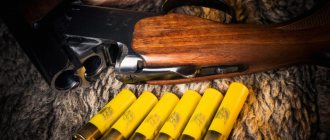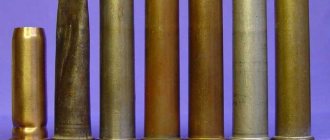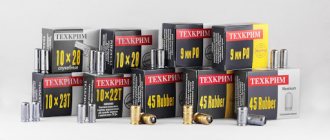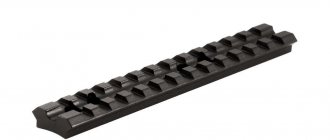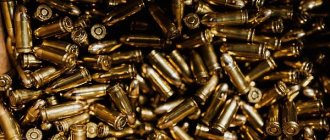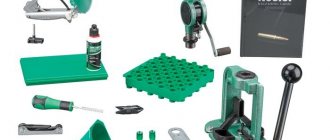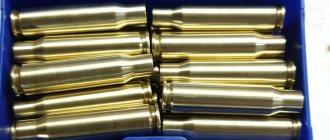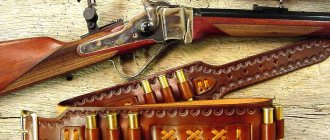Sokol gunpowder is the oldest of the domestic smokeless gunpowders, produced since 1937. In 1977, in connection with the release of a new state standard for smokeless powder, both the composition of the gunpowder and its quality characteristics were changed.
Although there are a large number of more modern gunpowders on the market these days, many of which are more effective than Sokol gunpowder, it still holds its own. Probably about 80% of the cartridges loaded by hunters are independently loaded with this gunpowder.
The Sokol is also supported by the fact that many manufacturers equip their cartridges with it, preferring it to other options due to its low cost.
Characteristics of Sokol gunpowder
Sokol gunpowder is a single base smokeless powder based on nitrocellulose. The Sokol powder grain has the shape of a rectangular plate with dimensions from 1.28 to 1.7 mm, with a thickness of 0.13 mm.
The surface of the grains is graphitized and gelled to prevent the grains from sticking together and electrification.
Falcon is produced in two grades: premium and first grade.
When burned in the barrel, it generates a pressure of 630 to 650 kgf/sq.cm. Its combustion speed is 2.2 m/s. Bulk density when loading cartridges is 0.510 kg/l.
Sokol gunpowder is not recommended for use with self-loading semi-automatic guns, especially gas-operated ones, due to the emission of sparks from unburnt particles of gunpowder through the barrel box, as well as clogging of the gun mechanisms responsible for reloading with these unburned particles.
Falcon is often the first gunpowder with which hunters begin to independently load cartridges. Indeed, it is ideal for beginners, as it forgives small errors in weighing and inaccuracies in weighing; in addition, on the Internet you can find many recommendations for equipping cartridges with this gunpowder, which also greatly simplifies the equipment process for beginners.
Advantages and disadvantages of gunpowder
Sokol gunpowder has been on the market for a very long time. During this time, hunters have long noticed all its pros and cons.
Advantages:
- massive and popular gunpowder on the domestic market. You can buy it in almost any gun store;
- high burning rate. Capable of satisfying most shooter needs;
- satisfactory indicators of powder gas pressure;
- ballistic stability and chemical inertness;
- reasonable price. Which ultimately gives a pleasant cost price for the finished cartridge;
- does not require high precision when hanging. Because of this, it is ideal for novice collectors who have just started collecting their own ammunition;
- being not the most powerful gunpowder on the market, Sokol deforms less the shot and the barrel of the weapon used, which has a positive effect on the service life of the gun and the efficiency of the charge.
Flaws:
- muzzle resistance is above average, which results in a loud shot by weapons standards;
- When fired, a lot of flame erupts from the barrel, and there is also noticeable recoil. This is especially noticeable with calibers 16 and 20, while with 12 gauge it is not so critical;
- “dirty” shot – the remains of gunpowder and its gases greatly contaminate the mechanism of the weapon;
- The powder is not suitable for use with semi-automatic weapons. And also with self-loading.
As we can see, the disadvantages are quite typical for not new and not the most expensive gunpowder, despite the fact that there are many more advantages, and they outweigh the disadvantages of the Falcon.
Powder weights Sokol
Powder weights Falcon is one of the most important issues that interests hunters who load cartridges. The manufacturer indicates data on packaging with this gunpowder that does not correspond to modern realities.
Recommendations for how much powder per charge date back to 1977. However, from the experiences of many hunters who, through trial and error, were able to choose the right mounts, we now know them for sure.
When loading cartridges, it is better to use electronic scales; special powder measurements do not always give an accurate result.
History of black powder
Berthold Schwarz, who legend credits with the invention of gunpowder in Europe around 1330
It is considered established that gunpowder was invented in China, where it was known in the form of a saltpeter-gray-coal mixture around the 10th century. The widely known work of F. Engels “Artillery”, written by him for the American New Encyclopedia, contained the following lines:
| In China and India, the soil abounds in natural saltpeter, and it is quite natural that the local population became familiar with its properties early... We have no information about exactly when the special mixture of saltpeter, sulfur and charcoal became known, the explosive properties of which gave it such great importance... The Arabs borrowed saltpeter and pyrotechnics from the Chinese and Indians. |
At first, black powder was used for entertainment purposes - making funny fires and something like rockets - and only later as a substance suitable for military purposes. Thus, in 1259, the Chinese described one of the first types of weapons that used gunpowder - the “spear of furious fire.” From the Arabs who lived in Spain, familiarity with the production and use of gunpowder during the 14th century spread throughout Europe. In Europe, according to legend, the German monk Berthold Schwartz is considered the inventor of gunpowder, but, obviously, gunpowder was known before him. Thus, the English philosopher and researcher Roger Bacon (c. - c.) wrote about the explosive composition of saltpeter-sulfur-coal known to him. For over five centuries, black powder was the only propellant and explosive in the world, widely used both in artillery and explosive shells, and in rockets.
Potassium nitrate is the main component of black powder
Charcoal is the second-largest component of black powder.
Sulfur is the third component of black powder
Initially, gunpowder was a mechanical mixture of saltpeter, coal and sulfur in the form of a very fine powder. Its combustion was poorly predictable, and fine powder was also unsafe, as it often led to damage or rupture of weapon barrels. Its power also left much to be desired. The issue of increasing the power of gunpowder was solved, apparently by accident, while solving another problem - reducing the hygroscopicity of this substance. Dust-like gunpowder, which existed in the 14th and 15th centuries, became wet very quickly due to the extreme hygroscopicity of saltpeter and the large area of contact of powder particles with air. These problems were largely solved at the beginning of the 16th century, when gunpowder began to be made into granules. Saltpeter-gray-coal powder, mixed with water, was turned into a paste, which was then dried in the form of lumps and, as necessary, ground into grains. This not only increased the safety of the gunpowder, but also simplified the loading process. It also turned out that the granules explode almost twice as powerfully as pulverized gunpowder of the same mass. In addition, granular powder, unlike fine powder, did not require additional empty space in the breech of the barrel for effective ignition - the gaps between the granules were sufficient for this. As a result, the weapon's power was significantly increased. Subsequently, the granulation technique was improved; the powder mass was pressed at high pressure, and after grinding, the uneven pieces were polished, which made it possible to obtain hard, shiny granules.
Calculation of the mass of the powder charge based on the manufacturer's recommendations
The weight can be recalculated based on the recommendations indicated on the powder packaging. If it is indicated on the package only for 12 gauge, multiply it by the appropriate coefficient. The coefficient for 16 gauge, for weighing 28 grams of shot is 0.815, the coefficient for 20 gauge, for weighing 23 grams of shot is 0.675.
For example, on the package of gunpowder the weight for 12 gauge is 1.8-2.2 grams of gunpowder per 34 grams of shot. We need to find out the weight of gunpowder, for this we get 1.8 * 0.815 and 2.2 * 0.815: for 16 gauge, for a charge weighing 28 grams, you need to pour 1.6-1.8 grams of gunpowder.
Application
Black powder was historically the first explosive and remained the only explosive used both for throwing projectiles and as a high explosive. This situation remained until the invention of other explosives in the middle of the 19th century. With the advent of smokeless powders, black powder was quickly replaced by them as a propellant. In the 1890s, new models of small arms and artillery of the armies of militarily advanced states began to be produced to use only smokeless gunpowder. In the Russian Empire, smokeless powder was approved as standard for three-line rifles of the 1891 model and guns of field, mountain, fortress, siege and coastal artillery by the artillery order of February 6, 1895.
However, black powder was not completely excluded from the military sphere. It found use as a propellant in various types of rocket weapons - for example, the expelling charge of the German Panzerfaust hand grenade launcher of the 1942 model consisted of gun black powder. In the same way, black powder was used in the first Soviet grenade launchers RPG-1 (which did not go into mass production) and RPG-2, which was in service not only with the USSR, but also with other countries. A 5-gram charge of black powder is used, for example, in the Bulgarian anti-personnel jumping mine PSM-1 and serves to eject it from the ground.
Powder elements made from black powder and having a density of 1.65 g/cm³ or lower burn irregularly
, that is, not in parallel layers. But if the gunpowder is compacted to 1.8 g/cm³ and higher, it burns in parallel layers and is very convenient, due to its high sensitivity to the flame beam, for use in fuses for transferring fire to the main explosive charge, in spacer tubes, etc. Favorable factor There is also a relatively small amount of gases released during its combustion, which allows it to be used in closed tubes without the danger of their rupture. Black powder can also be used in the primers of artillery cartridges to enhance the initiation beam of the flame.
Currently, in the civilian sphere, black powder is used in pyrotechnics, in the manufacture of fire cords and in some types of blasting operations for the extraction of expensive stone. It has still not lost its importance for amateur shooters and hunters, who sometimes load cartridges with black powder.
In Europe and the USA, there are public organizations that popularize hunting and sport shooting using black powder, muzzle-loading and other historical weapons. This direction is becoming increasingly popular every year, as it adds to hunting the necessary element of chance, which is completely removed by modern long-range weapons, communications and surveillance equipment. In many countries there are national associations of black powder shooting enthusiasts. In addition, large-scale historical reconstructions and filming cannot be done without the use of black powder. The legal regime for the production and sale of black powder varies depending on the country: in most European countries, black powder is produced in a factory on the basis of a special permit and is sold in hunting stores on the basis of a license and with a limited quantity. Weapons designed for their use are sold, transported, used and stored without restrictions; but there is also the reverse order: weapons are licensed on a general basis, and gunpowder is free if you have a weapons license. In the United States, the Gun Control Act of 1968 recognizes flintlock, percussion, muzzle-loading, etc. weapon systems using black powder as antiques; their circulation is not subject to weapons legislation [source not specified 2640 days
].
The ratio of the mass of the shot and the charge
The charge ratio, that is, the ratio of the mass of the shot to the mass of the charge, is from 15 to 18 for Sokol gunpowder, with an average value of 16.5.
When the charge ratio is reduced closer to 15, accuracy decreases, but the sharpness of the gun’s engagement increases.
When the charge ratio is increased closer to 18, accuracy increases, but the sharpness of the combat decreases.
By changing the charge ratio, the hunter can receive a cartridge with the characteristics he needs in terms of accuracy and sharpness of combat.
In any case, all attachments for a particular gun are tested empirically based on zeroing.
Gunpowder Irbis Okhota 35, Irbis Okhota 35M
Irbis Okhota 35 and Irbis Okhota 35M gunpowder were specially created for game hunting. Each of them has its own characteristics and properties.
The difference between these powders is that they can be used not only for 12-gauge cartridges, but also for 16- and 20-gauge cartridges, that is, these powders are compatible with a much wider range of smoothbore gun models.
Gunpowder Irbis Okhota 35 and Irbis Okhota 35M can be used with cardboard, metal or plastic cartridges.
The manufacturer reports the following characteristics of gunpowder:
- possibility of use in a wide range of temperatures
- soft recoil when shooting
- minimal amount of smoke when burning
- high shot accuracy
Gunpowder weights Irbis Okhota 35, Irbis Okhota 35M
Irbis Hunting 35 gunpowder must be placed in the cartridge case in an amount of 1.55-1.9 g, while the mass of the shot should be 29-35 g.
Irbis Okhota 35M gunpowder is used for working in harsher climates. It contains substances that ensure faster combustion of gunpowder. For it, you need to reduce the mass of the charge by about 15%.
Reducing the charge also increases the powder's effectiveness when operating in wet conditions.
Gunpowder of this brand should be weighed when assembling cartridges with an accuracy of ±0.05 g.
Wads for cartridges can be used from wood fiber, felt, polyethylene. The method of rolling cartridges is “Star” or “Rolling”.
Best before date
Sokol gunpowder is supplied in metal cans of 200 or 250 grams. Cans are packed in special zinc, and zinc in wooden boxes weighing 50 kg.
Gunpowder can be stored in a metal can for 6 years. Jars can be stored in zinc without loss of properties for up to 25 years.
When storing, you must comply with the storage conditions indicated on the can; storage in rooms with sudden temperature changes is especially unacceptable.
When working with black powder, you should pay attention to the following features:
1. There should be no caked lumps and especially powder dust in the gunpowder. 2. The color of the grains should be black or slightly brownish, and their surface should be shiny.
Lumps in black powder and a dull surface of the grains indicate that the powder has been dampened in the past and is most likely unusable. Powder dust burns very quickly, which leads to a sharp increase in pressure in the barrels and often causes them to burst.
Special care should be taken when handling and storing black powder, as it is one of the most fire-sensitive explosives. Black powder should not be stored near primers or smokeless powder.
Black powders deteriorate when wet, so they need to be stored in a dry place, preferably in an airtight container. It is most convenient to use a glass jar or bottle with a well-ground glass or rubber stopper for this purpose.
In the literature one can find different opinions about the possibility of using black powder with the Zhevelo primer. Some authors strongly do not recommend doing this, others completely allow such a combination and even recommend it when firing a bullet with cartridges charged with black powder.
Without our own experience of using such cartridges, we would still not recommend using them, since in this case too high pressure may arise in the central part of the bores.
Loading cartridges with Sokol gunpowder
When loading cartridges with Sokol gunpowder, some essential points should be taken into account:
- Gunpowder Sokol is highly versatile, suitable for loading both shot and bullet cartridges, almost any caliber: 12, 16, 20.
- When loading cartridges, use electronic scales, they provide higher measurement accuracy, loaded cartridges will be more ballistically stable, do not use a powder measure.
- Use quality capsules. Remember a simple rule: a shot starts with a primer, a high-quality primer means a high-quality shot.
- Carefully read the manufacturer's recommendations indicated on the can and follow them. Do not exceed the weight recommended by the manufacturer, this can lead to extremely undesirable consequences.
- When loading cartridges, be careful and careful; if you doubt the measured weight, weigh it again. Errors are not appropriate here.
- Check loaded cartridges by sighting. Only properly carried out zeroing can show the true qualities of your cartridges.
We load 20 gauge cartridges. For
We load 20 gauge cartridges. For myself, I collected some tips from hunters for 20-caliber equipment. Now I want to tell you what I have left regarding equipment. I hope some of it will be useful.
Instructions for loading cartridges with REX II powder Colleagues, for 20 gauge at 27/28gr. fractions, how many REX II
With the permission of the topicstarter, I’ll ask, I have IZH43 20/76, I’ve been loading cartridges all the time (I like it myself, and somehow I didn’t particularly bother with 1.7-1.65 Sokol for 24 g shot. But I wouldn’t pour that much without testing , if you equip containers and (most importantly) "star". In this case, in the 12th, the recommended weight is 2.1g, which corresponds to the "Falcon" in the 20th (not Magnum) - a maximum of 1.68-1.78g. In this In this case, for a Magnum shotgun, you can pour in even more. “Magnum” pressures (up to 90 MPa “crasher”) in a 20-gauge will be obtained with a weighing of Sokol gunpowder somewhere around 2.2-2.3 g. But you should think hard, But is it necessary? The pressure is already higher for the 20th than in the 12th, the shot will begin to “crumple.” The weights for the 20th are as follows: Sokol 1.4g.-summer, 1.5g.-winter. shot 24-25g. And the rest is up to your discretion, if you want to get a good cartridge, you need to shoot and look at the targets, that’s for another thread. And don’t waste your brains, rummage through magazines, literature, everything is there, accessible to the most stupid. PS: found it What is there to argue about? Fraction weights for 20s can be from 25g. and up to 28gr….this is a STANDARD 20 cal projectile. It may be late, but I have 3 20-gauge shotguns, TOZ-106, Sever-5.6x39 and TOZ-B, pre-war, apparently, in a shell in the barrel, the butt is not original. I usually load the cartridges myself.
Usually - in Sokol plastic from 1.5 to 1.75 grams, depending on the can, then according to the season, either PC and 28 gram shot, or a cardboard seal, felt, fiberboard, cardboard, 30 gram shot, twist. In brass, according to the second option, since I don’t use PC. main gun Sever and Tulka. Moreover, in Tulka the barrels are 700 mm, so I mainly shoot a combined shot charge of 5/3, 3/1, 1/00, because The gun's action is extremely close. I haven’t really figured out the North yet, I kept struggling with the rifled barrel. But he noted that magnum cartridges (factory) in the silhouette of a black grouse from 35 meters, etc. N 1 gives 1-3 hits, shot N 3 2-3 holes, shot N 5 to 5 but extremely chaotically. Factory-made 70-case cartridges give results much better, on average 2-3 hits, but not consistently. Cartridges Tehkrim, Fetter, Record, we don’t have any others. Yes, if in 16 caliber Rekord, oddly enough, gives a very good fight on IZH-12, then in 20 caliber it is not shooting, but dispersion of gunpowder that works. the orientation is this: wad gunpowder. cardboard - 2.5mm, felt wads, gunpowder charge
(Falcon 2.2;2.3 for 12cal) summer. -1.6 winter -1.7 shot shell 27gr. (just for the weight of your gun) vary only by reducing. increase the gunpowder….. until you get the desired results in terms of combat sharpness, accuracy and uniformity of the scree….. Good time, sorry if something is wrong. I'm talking about the Polev. I shot it with a saiga 20s several times, the falcon weight, as indicated in the equipment instructions, is 1.5-1.6 g. The bullet is straight for gunpowder and twist. I went through both a check and a paycheck, depending on which attachment I wanted to screw on. The “record” case is where the bullet fits with tension, and all the gunpowder burns out. But with REX I had no luck - wedge after wedge, and I posted photos of 2 cartridges on the page “Samples of REX gunpowder”, people were surprised, but I decided to give up with REX (well, that’s me, and you, as you please). Yes, if anyone I must, in the “hunter” near m. Kashirskaya today I saw “Bronze dies for twists of 12/16/20 calibers” t.324-42-49. Best regards. Shot 20 gauge cartridges filled with Rex powder. This is what happened. Cartridge equipment: plastic sleeve, KV-22 primer, Rex-II gunpowder, semi-automatic main cartridge, shot 8, star. Powder weight, shot weight, speed. 1. 1.25-24-401 2. 1.25-24-408 3. 1.30-24-418 4. 1.30-24-413 5. 1.25-26-390 6. 1.25 -26-387 7. 1.30-26-400 8. 1.30-26-402 I also shot Polev bullets with a heavy head (24gr) and magnum cartridges. The Polevs were loaded with a plastic case, KV-22 primer, Sokol gunpowder, bullet, rolling. Powder weight, speed. 1. 1.55-442 2. 1.55-439 Magnum cartridges (76 mm sleeve), polye sleeve, KV-22 capsule, sunar 42/2 gunpowder, semi-automatic main cartridge, shot 8, star. Powder weight, shot weight, speed. 1. 1.80-30-395 2. 1.80-30-393 All cartridges were shot from an Izh-27emm-1s-20k gun. The combustion of gunpowder is complete in all cases. I was given instructions for my REX II can that say: part 12 - 1.65+/-0.05 g of gunpowder 32 g of shot 16 - 1.45+/-0.05 g of gunpowder 28 g of shot 20 - 1, 25+/-0.05 g of gunpowder 24 g of shot I think the optimum for a cartridge with a container will be around 1.3 g, for the 12th I got 1.7 with PE. Table 1. Optimal weight of a shot shell Caliber 12 16 20 32 Gun weight, kg 3.4 3.3 3.1 3.0 Projectile ratio 1:100 1:110 1:120 1:145 Projectile weight, g 34 30 26 21 The weight of the charge that ensures optimal accuracy and sharpness of a shot projectile is recommended to be determined from Table 2. Table 2. Optimal charge weights for a shot cartridge Projectile weight, g 34 30 26 21 Smokeless powder “Falcon” Charge ratio 1:16 1:16 1:17 1:18 Charge weight, g 2, 15 1, 9 1, 5 1, 2
Approximate characteristics of hunting and sporting powders
For cartridges for smooth-bore weapons
Name of indicatorSunar - 32Sunar 35, PDP-automatic Sunar 42/1, 42/2, 42/3 (Sunar - Magnum), PDP-Magnum Caliber 12 12 12 16 20 Average speed at a distance of 10 m (25 m) from the muzzle, m/s, not less than 325 330 320
Difference between the highest and lowest values of shot (bullet) flight speeds, DV m/s, no more (probable deviation of speeds rv, m/s, no more) 20 20 20 Highest maximum pressure, kgf/cm2 (MPa), no more than 680 (67) 970 (95.1) 680 (67) 730 (72) 780 (76) Shot (bullet) mass, g 32 28-32 40-42 36 30 Bulk density of gunpowder, g/cm3, not less than 0.550-0.620 0.510-0.750 0.570-0.670 0.670-0.770 0.600-0.750 for PDP-Magnum optional Charge mass, g (approximately) 1.60-1.90 1.55-2.10 2.10-2.45 1.80-2 .10 1.50-1.80
When loading cartridges with Sunar-Magnum gunpowder, it is necessary to use appropriate igniter primers, this is especially true when loading cartridges for winter hunting. For equipment, capsules such as “Zhevelo-Powerful” are suitable; “KV-22”, F-615 “Fiocchi” (Italy), CX-1000 (France), F-688 (Italy) When loading 16- and 20-gauge cartridges, use the following weights of shot and Sunar-Magnum powder: : 2.1 g of gunpowder and 30-33 g of shot for the 16th caliber and 1.8 g of gunpowder and 25-29 g of shot for the 20th caliber. In addition, “Sunar-Magnum” gunpowder is used to equip bullet cartridges of 12-, 16-, 20-calibers, the bullet speed of which increases by 10-15% compared to cartridges equipped with “Falcon” and “Sunar” gunpowders.
Felt grease has better obturation and has less soot and lead. It is better to take wooden ones of a larger caliber, and place 2mm thick cardboard between the wads. 1. How much better is the obturation and how much less soot and lead is there? In the sense that is this a significant difference or can it be neglected in principle? If it’s significant, and it’s better not to neglect it, then post a link to competently laying out the felt.
2. If I understand correctly, then for the 20 you need a 16-gauge wood wad? How to stuff it in? He's not felt.
3. I only have felt wads. Should I use wood ones (if so, then for what) or will we break through with felt ones? I still haven’t understood their fundamental functional differences.
For a double-barreled shotgun under 20x76, I load it like this: 1.7 Sokol, a thick cardboard spacer for gunpowder, a “sandwich” of felt and fiberboard, a thin spacer, 30 grams of shot (or 29 grams of shot + 1 gram of starch), close the cartridge with a twist. Sharpness - 3-4 shot diameters at 35 meters. Such cartridges were used to kill raven, ducks, black grouse, hazel grouse, and hare. Sometimes at extreme distances. Wounded wounds are rare, mostly if you hit them, then there is enough game - no one is in a hurry anymore.
Sunar-410 is definitely discarded; it’s not worth using it at 20 k in Izh-58. Start with falcon, 1.4 - 1.5 per 24 - 25 g of shot. It also ignites well from the centrifuge in brass. You can use Sunar-35 and 42, but just select the hitch very carefully. Sunars give a strong deviation in pressure with a slight change in the weight. They ignite better from a centrifuge, but are more susceptible to the influence of temperature on the shot. For them, the conversion is simple - the mass of shot and gunpowder from a can for 12k is multiplied by 0.7, this is the maximum weight, it is absolutely impossible to exceed it. When using a plastic seal, you can further reduce the weight of the sunars.
There was already quite a lot of information on REX-II. Use the search. Don't think that gunpowder is so universal. From 24 to 35g it should not be used. His “best” range is 28 to 32g. At 24g it can be used “out of desperation”; the shot parameters will be noticeably inferior to purchased cartridges with the same shot weight. But it is not at all worth using this gunpowder if the shot weighs more than 32g. Or you will get low speed (poor sharpness) or excessive pressure. I'm already tired of repeating this.
On the 35 Sunar I loaded 1.7 grams of gunpowder per 30 grams of shot. Fine. I tried 2.2 powder for 28 shot on a falcon - complete crap, the recoil is crazy and the deformation of the shot is prohibitive. At 40 meters, the seven, one after another, entered the plywood to the diameter. REX 1.5 per 30 grams of shot works well. When loading cartridges into 76 cartridges for Saiga, keep in mind that the cartridge case must be tightened or stared at least 5 mm, otherwise it will not fit into the magazine. Only if the top cartridge is in the magazine. For myself, I collect all the cartridges with 28 or 30 grams of shot. I would do everything with 30 grams, but 30 grams of shot won’t fit into a 70 cartridge case, only on REX.
I didn’t shoot in winter, I don’t know. In the summer I beat great snipes with 1.5rex at 30 shot. They poured in with a bang, sometimes from extreme distances. As an example, I was wandering around the field and a couple of quacks flew into me, maybe 35 meters a little more. I landed both of them with the nine on the rex. I tried to sprinkle 1.6 - a lot. It kicks quite a bit, and the spread increases. For Saiga-20 REX1.5x30 is the best IMHO. I liked REX.
“In response to your request, I inform you that to switch from the powder charge indicated on the can of gunpowder <Irbis-hunting> for the 16x70 cartridge to the 20x70 cartridge, from the powder charge indicated for the 16x70 cartridge, subtract 0.2 grams of gunpowder, take the amount of shot in the 20x70 cartridge equal to 24 grams." :hunting:
NUMBER OF SHOTS IN 10 GRAMS Number of fractions 1. 2. 3. 4. 5. 6. 7. 8. 9. Number of pellets, pcs. 27 32 39 50 62 82 107 153 207
Encyclopedia of fishing: https://vk.com/wall-23927120?q=cartridges
https://vk.com/ohota_i_rybalka#post-23927120_5668
General operating principles
It should be noted right away that the metal dowels used in mounting guns have a special structure and configuration. They are very little similar to classic dowels. Outwardly, this type of fastener looks like a nail that has a washer located near the pointed end. It is its presence that guarantees high-quality and tight pressing of the fastener to the underlying surface.
The essence of the process of driving in fasteners using a construction tool is to fire a gun loaded with a dowel at a pre-designated location. Completion of this manipulation results in the fastener entering the material, and the washer moves to the top of the cap, which is subsequently fixed with it.
The fastening elements used when shooting with a mounting gun provide the ability to secure any materials on solid bases. It should be remembered that dowels should not be driven into highly porous material, otherwise the fastener will “go away” or the fastening will be fragile.
